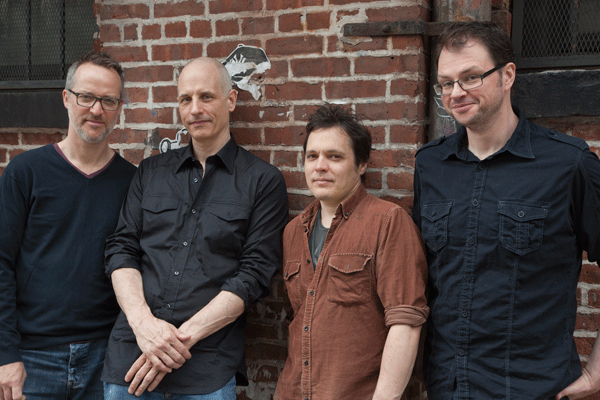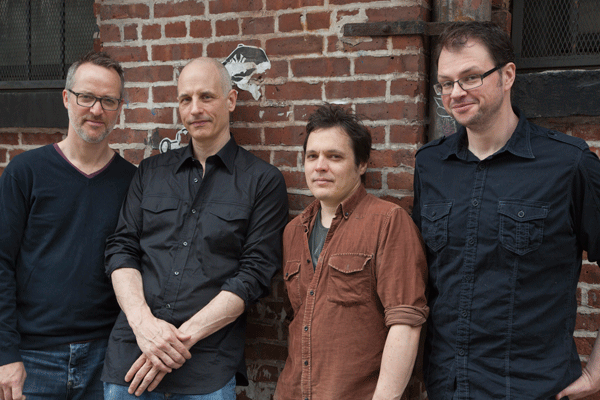
BY SAM SPOKONY | When Hurricane Sandy struck New York City on October 29, 2012, the cellist Erik Friedlander, now 53, was in the middle of writing music for the second recorded meeting of his Bonebridge quartet.
It had been about a year since their first album (an eponymous one) began the band’s texturally unique exploration of Americana via the avant-garde, with Friedlander’s signature plucked tone speaking, as in a meeting of brothers separated at birth, alongside the sympathetic slide guitar of Doug Wamble. And ever since that release, the cellist — with ears long-honed and tempered by his wide array of experimental sideman work, most notably with the composer John Zorn — had known that another album would have to follow soon, to continue the thought.
Bonebridge Quartet’s sophomore CD is slick, yet searching
So as the storm surged and the lights went out, Friedlander stayed put inside his home for the past 30 years — a Soho apartment by the corner of Grand and Crosby Streets — and he lit some candles.
“Once I realized we were going to be alright, I just kept writing,” said Friedlander. “I’d already sketched out some pieces before that point, but the hurricane really influenced the direction of the record, and some of the more moody pieces were written during that blackout period, as it got me thinking deeply about the nighttime, the darkness and how the city changed without power.”
MUSIC
ERIK FRIEDLANDER’S BONEBRIDGE QUARTET CD RELEASE CONCERTThursday, May 22
At Subculture
54 Bleecker St., btw. Bowery & Lafayette
Doors at 7pm, show at 7:30pm
$15 in advance, $20 day of show
For tickets: subculturenewyork.com
For artist info: erikfriedlander.com
One of those tunes, with deeply resonant opening phrases that instantly reveal the provocative timbre of the cello/guitar tandem, would become “Nighthawks” — a title the leader also went on to give to the entire album. The name, perhaps unsurprisingly, came from the iconic 1942 painting by Edward Hopper, which starkly portrays the late-hour customers at a semi-fictional Greenwich Village diner.
For Friedlander, Sandy’s impact on the city provided a new layer of introspection atop thoughts of that famous American scene.
“I was looking at some Hopper pictures and thinking more about the blackout, because I’d just never expected that curtain of black to fall over Lower Manhattan,” he said. “Then one day, during all the darkness, there was this guy who used a generator to set up his falafel stand on an empty street. It was the only light around, and some people started lining up to eat. And I thought, you know, this is a modern-day Hopper.”
That additional connection — to other places of quiet, of solitude — soon completed the psychological foundation of the record, which at times presents a kind of back-alley slickness alongside the more ethereal, searching elements of the specifically Sandy-inspired tunes.
The result, throughout the 10-track “Nighthawks” — which will be released on May 20, and premiered live at Subculture on May 22 — is a masterfully crafted follow-up to the original Bonebridge album, with the balance and interplay between the strings of Friedlander and Wamble inching ever closer to elusive perfection.
It only takes a few notes of the opener, “Sneaky Pete,” for the cello and guitar to nimbly climb to the top of the action, supported capably by bassist Trevor Dunn and drummer Michael Sarin (both returning from the first Bonebridge album). Unison riffs from Friedlander and Wamble quickly transition into solos that speak with a comfortably jazz-tinged vocabulary over the active rhythm section, before finishing out and stepping seamlessly into a relative swinger of a tune, “Clockwork,” which continues to feature strong solo phrasing from the cellist, who remains supremely relaxed without ever sounding tired.
From there, things become more intimate as we delve into the meat of those directly blackout-inspired tunes, with “Hopper’s Blue House” leading the way into longer, sweeping tones and tightly controlled, medium-soft dynamics that always serve to strengthen the imagery of the scene.
Increasingly sensitive exchanges between the cello and guitar continue in “Nostalgia Blindside” and “One Red Candle,” both largely written in Sandy’s aftermath (with the latter’s title coming from Friedlander’s method of lighting his workspace at that time). Alongside Wamble’s subtle slides and twangs, the sheer emotion in Friedlander’s playing — which sometimes compels him to pick up the bow — even reaches points at which he seems to be wistfully recalling those quiet days of darkness, which, amid their disastrous effects, brought a briefly placid temperament to his home streets.
Wamble particularly shines on two of the album’s more Hopper-inspired tunes, carrying the late-night haunt names of “26 Gasoline Stations” and “Poolhall Payback.” The guitarist shows himself to be both a savvy accompanist — with a beefy tone and solid time that often helps drive Friedlander’s improvisational flights — while also remaining alternately fresh and snappy or rich and soulful in his solos, depending on the mood required.
The cello/guitar collaboration reaches one of its top peaks in the title track, as both players lower the volume even further and dig most deeply into that intimate feeling of post-storm calm that permeates the album. Here, along with flashes of brilliance on the closing track, “The River,” is where Friedlander most shows his maturity, as a player who can carry the flag of the avant-garde without drowning in noise or notes.
“When I was younger I was more interested in bravado, and I really wanted to wow the audience,” said the cellist, thinking of his personal development in the context of the new album. “Fireworks are exciting and fun, but there’s another side, which is to be vulnerable, to allow yourself to be open to something rather than crushing it with strength and speed, and that’s what can give an audience a really new and different sense of what I’m about it.”
Friedlander also pointed out that one of the most important parts of completing that feeling on “Nighthawks” was, effectively sharing the lead playing once again with Wamble.
“It’s always been a source of complete joy for me, that interplay between the cello and slide guitar,” he said. “Sometimes I even feel like I’m a straight man for Doug’s guitar, because it has lot of humor and soulfulness, and the guitar also sets off the soulfulness of the cello in a unique way. I’m just turned on by that chemistry, and it’s really the heartbeat of the band.”
It’s a heartbeat that doesn’t need to beat loudly to show the strength of its pulse — and “Nighthawks” is a decidedly low-key album that deserves as much praise, for its conception and execution, as any more ostensibly complicated work coming out of the jazz or avant-garde music scenes.

































